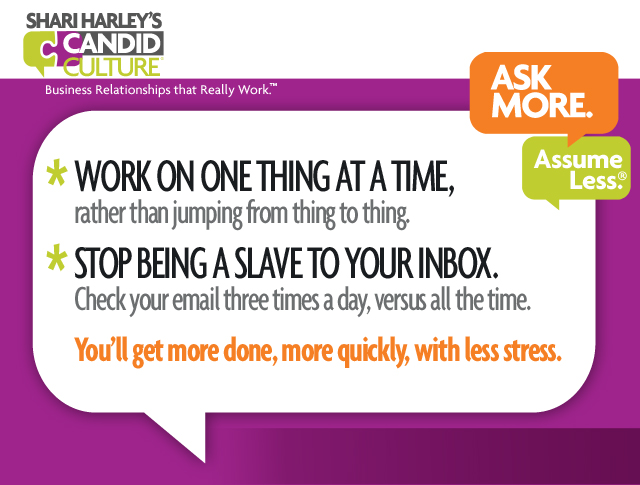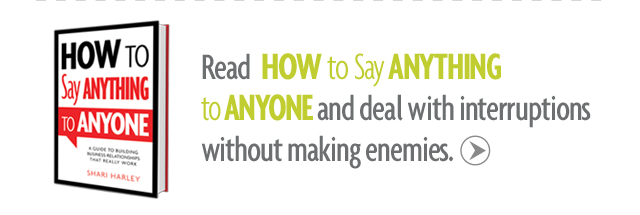Posts Tagged ‘workplace productivity’
Reading emails as they come in is killing your productivity.
You’re at your desk working on a project. Aka, doing actual work. You think, “It’s been three minutes. I should check my email.” So you take your attention off your project and check your email. Then you read the five emails that came in since you last checked email. You then go back to the project you were working on and spend 10 to 20 minutes trying to get your head around what you were doing before reading those very important emails. Finally, you’re back in the groove. You do five minutes of work and think, “I should check my email.” Then it’s 5:30 pm and you realize, with frustration, that you finished nothing all day.
 Sound familiar?
Sound familiar?
Living in our email inbox is why many of us start work at 5:00 pm or come into the office at 7:00 am to get “something done while it’s quiet.” It’s why we sleep and go on vacation with our phones, and are never really off.
I am most productive on airplanes without WIFI. Without WIFI I’m not tempted to check my email every three minutes or check Facebook to read about what people I barely know and don’t really care about are doing.
Without WIFI all there is to do is what I need to do. There are no other meaningful distractions, except for the B-grade movie I didn’t really want to see anyway. I am focused. And as a result, I get a lot done. I’m also less stressed. Because I’m focused, doing one thing a time, I’m not worried about everything I still need to do.
If you want to get more done and be less stressed, do one thing at a time, for a defined period of time. Decide how long you’re going to work on something, and work on that item for that period of time, with no distractions or interruptions. You may only work on something for ten or twenty minutes, but do only what you said you would do for that time period. Then you can check your email.
Productivity experts suggest you only check your email three times a day, for example, once in the morning, right before or after lunch, and at the end of the day. I find this hard to do. Like you, I feel pressured to check my inbox. Or I use my email to avoid the work I really need to do. But I know that constantly being in my email inbox has me distracted and not doing the work I really need to do. And as a result, I’m stressed and spend my evenings and weekends working on projects that require focused time.
Do one thing at a time, for a defined period of time. Just try it. If you’re going to read your email, give yourself 20 minutes, and do nothing but read, reply, and delete email. At the end of 20 minutes, do whatever you said you would do next, for as long as you decide, and nothing else.
See if you get more done, in less time, with less stress. You might just leave work earlier and have time to do something besides work.

As crazy as it sounds, it can be difficult to get work done at work. There are the drive bys – people who want your opinion on EVERYTHING before they make decisions, the interrupters who have just one question, several times a day, the visitors who want to update you on EVERYTHING happening in their personal lives, and coworkers who host meetings at their workstation, take phone calls on speaker phone, and who listen to music without headphones, while loudly eating potato chips. All of these distractions are enough to make many employees want to find a quieter place to work.
have just one question, several times a day, the visitors who want to update you on EVERYTHING happening in their personal lives, and coworkers who host meetings at their workstation, take phone calls on speaker phone, and who listen to music without headphones, while loudly eating potato chips. All of these distractions are enough to make many employees want to find a quieter place to work.
The concept that it can be hard to get work done at work is crazy. We’re at work to work. And yet many employees, with and without a door, get in at 7:00 am, before others arrive, so they can “get some work done” and stay late because they “got nothing done all day.”
Open work environments can be productive and interruptions can be minimized, but managing interruptions at work will require some clear guidelines and direct communication, which many workplaces are missing.
Managing interruptions at work – practices for creating a work environment that works for everyone:
Write workspace practices down, share them with all employees, post the practices in every work area, and discuss them frequently.
Examples of practices for managing interruptions at work:
- Use a headset for all phone calls.
- Pay attention to your volume. Speak as quietly as possible.
- If you have visitors at your desk for business or non-business related conversations that last longer than five minutes, take the conversation to a conference room, empty office, or local coffee shop.
- Use headphones to watch videos and listen to music.
- Avoid prairie dogging—calling down a row, hallway, or over a cubicle wall. Instead, walk to the person’s desk, call, or send an email or text message.
- Turn off all auditory alerts on computers and cell phones, so your coworkers don’t have to hear pinging and ringing all day. The people you sit with don’t need to know every time you receive an email, text, or Facebook message.
- Finally, but MOST IMPORTANTLY, give all employees permission to make requests and give feedback when workspace guidelines are broken. It must not only be acceptable but expected that employees will say something when a guideline is broken and the workspace gets too loud.
Most employees will not speak up when others are being loud. It’s easier to find another location to work than risk a coworker’s defensive response. And no one wants to be ‘that person’ who complains about how loud someone is. If employees aren’t comfortable speaking up and making requests, offer training on how to have these conversations, and provide written examples of what employees can say that is respectful and clear.
Guidelines for dealing with interruptions at work:
You’d think that having a door would make people immune to work place distractions, but that’s not the case. Employees with offices also deal with drive bys and interruptions. The key to dealing with both is communication.
- Don’t wait for problems to occur. Anticipate challenges and talk about them before guidelines are broken. It’s much easier to make a request than to give feedback.
- Each time a new person joins a team, department, or workspace, ask everyone on the team to share their work-related pet peeves, how they like to communicate, and how they prefer to be interrupted. Everyone deals with interruptions, so you might as well express a preference. If you’d prefer people email you and ask when you have time for a quick question, make that request. If you’re ok with people interrupting you without notice, let people know. If you’re not distracted by noise, tell people. If you are, make that preference known.
People are too hesitant to speak up at work for fear of damaging relationships and hurting people’s feelings. The best thing leaders can do to improve the working environment (or any workplace challenge) is to set clear expectations, create opportunities to talk about how things are going, and make it ok to speak up.
Suffering at work is optional. Everyone is accountable for the work environment, and you won’t get what you don’t ask for.

 As crazy as it sounds, it can be difficult to get work done at work. There are the drive bys –people who want your opinion on EVERYTHING before they make decisions, the interrupters who have just one question, several times a day, the visitors who want to update you on EVERYTHING happening in their personal lives, and coworkers who host meetings at their workstation, take phone calls on speaker phone, and who listen to music without headphones, while loudly eating potato chips. All of these distractions are enough to make many employees want to find a quieter place to work.
As crazy as it sounds, it can be difficult to get work done at work. There are the drive bys –people who want your opinion on EVERYTHING before they make decisions, the interrupters who have just one question, several times a day, the visitors who want to update you on EVERYTHING happening in their personal lives, and coworkers who host meetings at their workstation, take phone calls on speaker phone, and who listen to music without headphones, while loudly eating potato chips. All of these distractions are enough to make many employees want to find a quieter place to work.
The concept that it can be hard to get work done at work is crazy. We’re at work to work. And yet many employees, with and without a door, get in at 7:00 am, before others arrive, so they can “get some work done” and stay late because they “got nothing done all day.”
Open work environments can be productive and interruptions can be minimized, but managing interruptions at work will require some clear guidelines and direct communication, which many workplaces are missing.
Managing interruptions at work – practices for creating a work environment that works for everyone:
Write workspace practices down, share them with all employees, post the practices in every work area, and discuss them frequently.
Examples of practices for managing interruptions at work:
- Use a headset for all phone calls.
- Pay attention to your volume. Speak as quietly as possible.
- If you have visitors at your desk for business or non-business related conversations that last longer than five minutes, take the conversation to a conference room, empty office, or local coffee shop.
- Use headphones to watch videos and listen to music.
- Avoid prairie dogging—calling down a row, hallway, or over a cubicle wall. Instead, walk to the person’s desk, call, or send an email or text message.
- Turn off all auditory alerts on computers and cell phones, so your coworkers don’t have to hear pinging and ringing all day. The people you sit with don’t need to know every time you receive an email, text, or Facebook message.
- Finally, but MOST IMPORTANTLY, give all employees permission to make requests and give feedback when workspace guidelines are broken. It must not only be acceptable but expected that employees will say something when a guideline is broken and the workspace gets too loud.
Most employees will not speak up when others are being loud. It’s easier to find another location to work than risk a coworker’s defensive response. And no one wants to be ‘that person’ who complains about how loud someone is. If employees aren’t comfortable speaking up and making requests, offer training on how to have these conversations, and provide written examples of what employees can say that is respectful and clear.
Guidelines for dealing with interruptions at work:
You’d think that having a door would make people immune to work place distractions, but that’s not the case. Employees with offices also deal with drive bys and interruptions. The key to dealing with both is communication.
- Don’t wait for problems to occur. Anticipate challenges and talk about them before guidelines are broken. It’s much easier to make a request than to give feedback.
- Each time a new person joins a team, department, or workspace, ask everyone on the team to share their work-related pet peeves, how they like to communicate, and how they prefer to be interrupted. Everyone deals with interruptions, so you might as well express a preference. If you’d prefer people email you and ask when you have time for a quick question, make that request. If you’re ok with people interrupting you without notice, let people know. If you’re not distracted by noise, tell people. If you are, make that preference known.
People are too hesitant to speak up at work for fear of damaging relationships and hurting people’s feelings. The best thing leaders can do to improve the working environment (or any workplace challenge) is to set clear expectations, create opportunities to talk about how things are going, and make it ok to speak up.
Suffering at work is optional. Everyone is accountable for the work environment, and you won’t get what you don’t ask for.

 You have too much to do and not enough time. Something has to go. You have four choices:
You have too much to do and not enough time. Something has to go. You have four choices:
- Get further behind at work
- Have less fun
- Spend less time with your kids, spouse and/or friends
- Sleep less
Most people forgo sleep in favor of work, fun, and time with family and friends. But this choice, like all choices, has consequences.
I’ll admit to being a bad sleeper. I stay up too late stalking people on Facebook who I don’t care about. Then I wake up in the middle of the night to use the facilities and have trouble falling back to sleep. Instead of quieting my mind, I make to-do lists on my phone, which, yes, I sleep with. I am quite functional with five hours of sleep for one or two days. The third day I’m a disaster – cranky and unproductive.
Most people need more sleep than they’re getting. With enough sleep everything works better. With a lack of sleep nothing seems to work. We would actually increase productivity if we slept more. Mornings would start better, days would be more efficient, and the people we work and live with would like us more.
But the problem remains, most people don’t feel they have enough time. And something has to go.
Here are a few things I’m trying to increase productivity:
- Set realistic goals. I’m probably not going to go to be at work at 8:00 am, go to the gym, and see friends five days a week. Three days is more realistic.
- Put the phone on the other side of the room when I go to bed, so it still serves as an alarm clock but isn’t within arm’s reach.
- Don’t read or reply to email in the middle of the night.
- Wind down earlier. Start getting ready for bed 30 minutes before I want to go to sleep.
- Accept that I need more sleep and that while four or five hours worked while I was in college, I’m no longer 20.
- Realize that when I get seven hours of sleep I’m nicer to be around. I feel better and am more productive.
When human beings sleep seven or eight hours a night we are more focused, happier and we increase productivity. Thus sleeping more actually creates more time.
Commit to feeling better and enjoying your work and personal life more by getting more sleep. But if you opt to stay tired and cranky, email me at 3:00 am and we’ll catch up.
 Sound familiar?
Sound familiar?


 have just one question, several times a day, the visitors who want to update you on EVERYTHING happening in their personal lives, and coworkers who host meetings at their workstation, take phone calls on speaker phone, and who listen to music without headphones, while loudly eating potato chips. All of these distractions are enough to make many employees want to find a quieter place to work.
have just one question, several times a day, the visitors who want to update you on EVERYTHING happening in their personal lives, and coworkers who host meetings at their workstation, take phone calls on speaker phone, and who listen to music without headphones, while loudly eating potato chips. All of these distractions are enough to make many employees want to find a quieter place to work.
 You have too much to do and not enough time. Something has to go. You have four choices:
You have too much to do and not enough time. Something has to go. You have four choices: